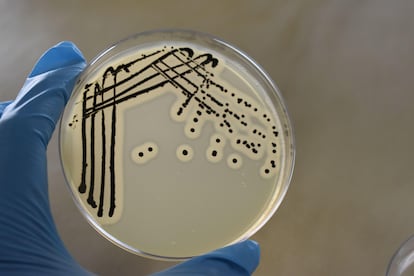Superbacteria’s double defense against antibiotics is discovered
Methicillin-resistant Staphylococcus aureus, which causes 120,000 deaths a year, adopts an alternative mode of cell division to ensure its survival, new study finds

A handful of microbes have put global health on the ropes. They are the superbugs, considered by the World Health Organization (WHO) to be one of the 10 main threats to public health and responsible for 1.27 million deaths a year. The WHO is specifically targeting 15 microorganisms considered “highly dangerous” due to their resistance to the arsenal of available antibiotics and their ability to spread or transmit resistance to other bacteria. Sworn enemies include, for example, resistant Gram-negative bacteria, Salmonella, Shigella, Pseudomonas aeruginosa and the methicillin-resistant Staphylococcus aureus, among others. Regarding the latter, research published on Thursday in the journal Science has delved into their mechanisms for escaping antimicrobials and has discovered that, in order to be highly resistant, these microbes adopt a double defense.
Methicillin-resistant Staphylococcus aureus (MRSA) alone causes around 120,000 deaths a year worldwide. It is “a serious global threat,” explains Simon Foster, a researcher at the University of Sheffield (United Kingdom) and author of the study, which reveals a new defense mechanism for this bacteria. Methicillin was the antibiotic traditionally used against this microbe, but due to the appearance of MRSA and the toxicity of the drug itself, Foster explains, it was no longer being used. The problem is that methicillin belongs to a broader family of antibiotics, beta-lactams, and MRSA has become resistant to almost all of them. “MRSA can sometimes be treated with other antibiotics, such as linezolid or tetracycline. However, for serious infections, such as bacteremia or endocarditis, daptomycin or vancomycin must be used. The problem is that resistance has developed against each of them,” explains the expert.
The scientific community has long since discovered that MRSA had a peculiarity: it had acquired a gene that encodes a component called MecA, which helps form the bacteria’s cell walls so that it can grow and divide. This genomic peculiarity makes it resistant, but researchers knew that this characteristic alone was not enough to be highly resistant. “It was also known that there are other small changes that occur in bacteria that allow a big jump in the level of resistance,” Foster adds in an email response. Scientists thought that these small genetic changes, called “enhancers” in scientific jargon, allowed MecA to work better.
However, the University of Sheffield researcher explains, his new discovery has turned the initial assumptions on its head and has revealed that these enhancers “are not related to the activity of MecA, but are part of another mechanism necessary for high-level resistance.” Specifically, the authors discovered that MRSA adopts an alternative mode of cell division in the presence of antimicrobials to ensure its survival. “By using the newly discovered mechanism, bacteria divide in a different way that does not require a key activity that is normally needed for them to divide and multiply,” says the researcher.
These two defense mechanisms are synergistic: “Both are necessary for high-level methicillin resistance. MecA needs to be resistant at a low level, about 10 times more than a sensitive strain, and potentiation needs to be resistant at a high level, about 1,000 times more than a sensitive strain. Potentiation alone does not make them resistant,” says Foster.
According to the authors, their discovery opens the door to finding new therapeutic strategies to fight antibiotic resistance. Foster argues that the discovery of this new division mechanism, hitherto unknown, is important on two levels: “Firstly, it has been shown that these bacteria have the ability to divide in a way that was previously unknown, which sheds light on the mechanisms that sustain the life of this organism. Secondly, it shows that the development of resistance is more complex than we had previously imagined and uses the newly discovered pathway, which has important ramifications for the development of new treatments to control MRSA.” The scientist assures that there are already compounds to which this resistant bacteria is vulnerable, and the activity in each of its two defense systems could be mapped to find other new treatments.
A worrying pathogen
Bruno González-Zorn, director of the Antimicrobial Resistance Unit at the Complutense University of Madrid and advisor to the WHO in this field, stresses that MRSA is one of the pathogens “that causes the most mortality and the most concern at the hospital level” and any advance in the knowledge of the biology of the resistance it generates, such as this research, is important: “It is an article on fundamental biology where it describes that MRSA acquires a gene that confers resistance. But one in every 10,000 of these manages to have a very high resistance and, until now, it was not known what made it highly resistant because that gene alone was insufficient. The new discovery will not have an immediate clinical implication, but it does open the door to designing molecules to inhibit that high level of resistance,” reflects the microbiologist, who has not participated in this research.
María del Mar Tomás, a microbiologist at the A Coruña University Hospital Complex and spokesperson for the Spanish Society of Infectious Diseases and Clinical Microbiology (SEIMC), has a similar opinion: “It is extremely interesting. Many investigations have focused on the classic resistance mechanisms, those that act on antibiotics, but this study looks at the tolerance and stress mechanisms of the bacteria, which can also influence resistance.” Tomás points out that Foster’s research, in which she did not participate, finds “the perfect link” to explain the high resistance of MRSA to antibiotics: “It is a mechanism that combines the union of MecA with a mutation in enhancer genes related to cell division: the bacteria grows in a different, abnormal and disordered way, but it manages to stop the antibiotic from acting.”
The research published in Science also raises new questions, Foster admits. For example, whether MRSA may have other hidden mechanisms to evade antibiotics: “Our discovery of this new mechanism using an alternative division strategy demonstrates how little we know. We are currently working to elucidate the basis of the alternative division mode and how enhancers actually work to promote resistance. This allows us to discover a whole range of cellular capabilities that we can now explore. There is always more to discover and understand,” the scientist says.
Another question is whether these same defense pathways are replicated in other resistant bacteria. For now, Foster says, enhancers are associated with resistance to other types of antibiotics and have been found in other bacteria. “We are working to determine whether there is a common thread between bacteria and whether this mechanism is more frequent than we had previously suggested,” he says.
Sign up for our weekly newsletter to get more English-language news coverage from EL PAÍS USA Edition
Tu suscripción se está usando en otro dispositivo
¿Quieres añadir otro usuario a tu suscripción?
Si continúas leyendo en este dispositivo, no se podrá leer en el otro.
FlechaTu suscripción se está usando en otro dispositivo y solo puedes acceder a EL PAÍS desde un dispositivo a la vez.
Si quieres compartir tu cuenta, cambia tu suscripción a la modalidad Premium, así podrás añadir otro usuario. Cada uno accederá con su propia cuenta de email, lo que os permitirá personalizar vuestra experiencia en EL PAÍS.
¿Tienes una suscripción de empresa? Accede aquí para contratar más cuentas.
En el caso de no saber quién está usando tu cuenta, te recomendamos cambiar tu contraseña aquí.
Si decides continuar compartiendo tu cuenta, este mensaje se mostrará en tu dispositivo y en el de la otra persona que está usando tu cuenta de forma indefinida, afectando a tu experiencia de lectura. Puedes consultar aquí los términos y condiciones de la suscripción digital.
More information
Archived In
Últimas noticias
There is as much life left to discover on planet Earth as that which is already known
Dozens presumed dead, around 100 injured in fire at Swiss Alps bar during New Year’s celebration
Is porn for women different from conventional porn? We spoke to those who make it
Cartagena de Indias is sinking: What can the city do to mitigate it?
Most viewed
- David King, chemist: ‘There are scientists studying how to cool the planet; nobody should stop these experiments from happening’
- Reinhard Genzel, Nobel laureate in physics: ‘One-minute videos will never give you the truth’
- Oona Chaplin: ‘I told James Cameron that I was living in a treehouse and starting a permaculture project with a friend’
- Sinaloa Cartel war is taking its toll on Los Chapitos
- The Interoceanic Train, the Mexican alternative to the Panama Canal










































